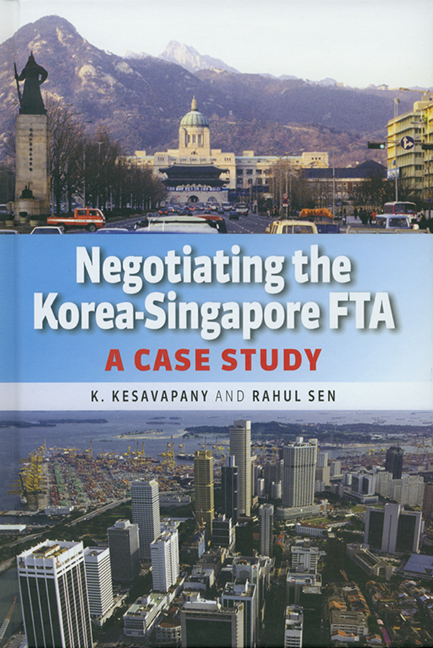Book contents
- Frontmatter
- Contents
- Foreword
- Preface
- 1 Background to the Korea-Singapore FTA
- 2 Singapore and Korea: Expanding Economic Linkages
- 3 Korea-Singapore Economic Relations After FTA: Towards a Mature Partnership
- 4 Salient Features of the KSFTA and Expected Benefits for Singapore
- 5 Singapore-Korea Business Linkages Post-KSFTA and Implementation
- 6 Concluding Remarks
- Notes
- References
- Appendix The Free Trade Agreement Between Korea and Singapore
3 - Korea-Singapore Economic Relations After FTA: Towards a Mature Partnership
Published online by Cambridge University Press: 21 October 2015
- Frontmatter
- Contents
- Foreword
- Preface
- 1 Background to the Korea-Singapore FTA
- 2 Singapore and Korea: Expanding Economic Linkages
- 3 Korea-Singapore Economic Relations After FTA: Towards a Mature Partnership
- 4 Salient Features of the KSFTA and Expected Benefits for Singapore
- 5 Singapore-Korea Business Linkages Post-KSFTA and Implementation
- 6 Concluding Remarks
- Notes
- References
- Appendix The Free Trade Agreement Between Korea and Singapore
Summary
INTRODUCTION
This chapter explores the implications of the Korea-Singapore Free Trade Agreement (KSFTA) for Korea-Singapore economic relations. It is organized as follows. Section 2 analyses Korea's Trade Policy Strategy and highlights the importance of FTAs. Section 3 analyses the current state of bilateral economic relations between the two countries. Section 4 analyses the implications of the KSFTA for bilateral relations, and concludes the chapter by providing strategies for win-win cooperation.
In 2005, Korea ranked 11th among the world's largest economies with a gross domestic product (GDP) of about US$790 billion. It was only the twelfth country to pass the US$500-billion mark in trade volume after countries such as the U.S., Germany, Japan and China. Between 1970–2004, Korea achieved 10.1 per cent average in annual GDP growth rate. In 2003–05, Korea exhibited moderate economic growth of 4–5 per cent due to stagnant domestic demand. In 2006, the real GDP growth rate was expected to be around 5 per cent, with private consumption growth around 3–5 per cent, equipment investment growth 5–9 per cent and exports another 8–12 per cent. The economy is expected to grow by 4.3 per cent per annum till 2020. Because of sluggish growth of inputs, the potential GDP growth rate is likely to decline for the next 15 years. Total factor productivity is expected to contribute more significantly.
The Korean Economy
The Korean economy currently ranks number one in the world's shipbuilding industry, accounting for 41.2 per cent of the global shipbuilding production. The Korean steel industry has also emerged as an influential producer worldwide and ranks fifth largest in the world, producing 46.3 million tons of steel per year. It is also the world's No. 6 manufacturer of automobiles and produced 3.7 million cars in 2005.
- Type
- Chapter
- Information
- Negotiating the Korea-Singapore FTAA Case Study, pp. 13 - 18Publisher: ISEAS–Yusof Ishak InstitutePrint publication year: 2007

